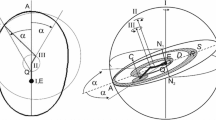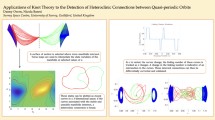Abstract
For coplanar circular orbits, the mutual perturbations between two bodies can be expressed in term of the argument of Jacobian elliptic functions instead of the difference of the mean longitudes. For a given pair of planets, such a change of time variable improves the convergence of the developments. At the first order of planetary masses an integration of Lagrange's equations for the osculating elements is performed. When compared to classical developments the results are reduced by an important factor. The method is then extended to the mutual perturbations of Jupiter and Saturn, at any order of planetary masses, either with Fourier series with two arguments, or with one argument solely, taking advantage of the close commensurability of the mean motions.
Similar content being viewed by others
References
Abramowitz, M. and Stegun, I. A.: 1968,Handbook of Mathematical Functions, Dover Publications, Inc., New York.
Brumberg, V.A.: 1992, General Planetary Theory Revisited with the aid of Elliptic Functions,Proc. 25th Symp. Celestial Mechanics (Tokyo), Eds H. Kinoshita and H. Nakai.
Brumberg, V. A.: 1994, General Planetary Theory in Elliptic Function,Celest. Mech. 59, 1.
Brouwer, D. and Clemence, M. C.: 1961,Methods of Celestial Mechanics, Academic Press, New York.
Chapront, J.: 1994, Representation of Planetary Ephemerides by Frequency Analysis, Application to the five outer Planets,Astron. Astrophys. Suppl. Series,109, 181.
Deprit, A.: 1979, Note on Lagrange's Inversion Formula,Celest. Mech. 20, 325.
Klioner, S. A.: 1992, Some Typical Algorithms of the Perturbation Theory within MATHEMATICA and their Analysis,Proc. 25th Symp. Celestial Mechanics (Tokyo), Eds H. Kinoshita and H. Nakai.
Simon, J. L. and Bretagnon, P.: 1984, Théorie du mouvement de Jupiter et Saturne sur un intervalle de temps de 6000 ans, Solution JASON84,Astron. Astrophys. 138, 169.
Simon, J. L., Bretagnon, P., Chapront, J., Chapront-Touzé, M., Francou, G., and Laskar, J.: 1994, Numerical expressions for precession formulae and mean elements for the Moon and the planets,Astron. Astrophys. 282, 663.
Simon, J. L. and Francou, G.: 1982, Amélioration des théories de Jupiter et Saturne par analyse harmonique,Astron. Astrophys. 114, 125.
Simon, J. L. and Joutel, F.: 1988, Calcul des perturbations mutuelles de Jupiter et Saturne en fonction d'une seule variable angulaire,Astron. Astrophys. 205, 328.
Szebehely, V.: 1967,Theory of Orbits, Academic Press, New York.
Tisserand, F.: 1894,Traité de Mécanique Céleste, Gauthier-Villars, Paris.
Williams, C.C., Van Flandern, T., and Wright, E.A., 1987, First Order Planetary Perturbations with Elliptic Functions,Celest. Mech. 40, 367.
Author information
Authors and Affiliations
Rights and permissions
About this article
Cite this article
Chapront, J., Simon, JL. Planetary theories with the aid of the expansions of elliptic functions. Celestial Mech Dyn Astr 63, 171–188 (1995). https://doi.org/10.1007/BF00693412
Received:
Accepted:
Issue Date:
DOI: https://doi.org/10.1007/BF00693412




